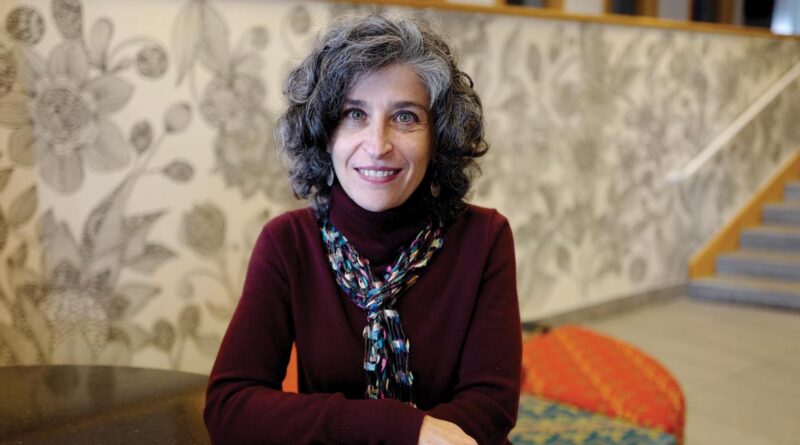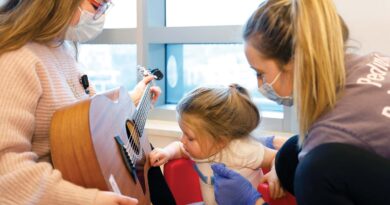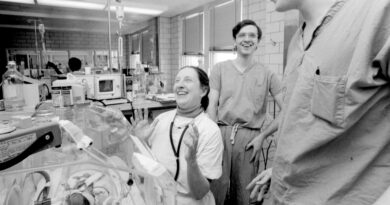Connection and Community
Published on March 17th, 2022 by Christina Echegaray.
Ten years ago, five mothers and their children, ages 5 weeks to 2 years, gathered in the Pediatric Primary Care Clinic at Monroe Carell Jr. Children’s Hospital at Vanderbilt seeking a community of health care in a place where their cultural and language needs were met and understood.
For a half day, once a week, Adriana Bialostozky, MD, and another primary care physician, along with nurses — all bilingual — led group well-child visits for Spanish-speaking mothers and their young children.
The program, Mi Bebé y Yo (My Baby and Me), launched as an initiative at Children’s Hospital to help Latina mothers navigate and access quality pediatric health care while forming cultural bonds and relationships. One group grew into five to eight groups of mothers and children a year. The group allowed mothers to explore issues important to them, like sleep routines and discipline, and ensure their children were meeting important health milestones.
“I’ve always thought about how to create different spaces for our families to be seen in clinics,” said Bialostozky, associate professor of Pediatrics. “It’s a beautiful model because it was a way of doing anticipatory guidance and building a community.”
Mi Bebé y Yo was among the first of several programs Bialostozky launched after arriving at Children’s Hospital in 2005 to augment care for Spanish-speaking families and close care gaps, all to fill their medical and social needs. Her mission to support those needs has expanded exponentially into other areas over the years as she focuses on patient education, community advocacy and training future generations of doctors fluent in Spanish.
“I knew when I came to Vanderbilt that I wanted to work with the Latino population,” she said. “I am extremely privileged to work with the Latino community. They are incredibly thoughtful and careful of their children.”
As Bialostozky has cultivated the size and scope of programs for Spanish-speaking families, more Latinos have also moved to the Nashville area.
Since the 2000 U.S. Census, the Hispanic-Latino population in Nashville-Davidson County nearly tripled, growing from about 26,000 residents to the current 72,200 residents, or about 10.4% of the area’s population. That growth has been mirrored in the Pediatric Primary Care Clinic at Children’s Hospital. About 10% of Children’s Hospital patients identify as Hispanic-Latino.
In 2011, she created the Spanish Language Clinic within the Pediatric Primary Care Clinic at Children’s Hospital.
The Spanish Language Clinic, with sessions multiple days a week, is staffed by bilingual pediatricians, residents and nurses on the eighth floor of Doctors’ Office Tower at Children’s Hospital. The clinic, which addresses the medical and social needs of the Spanish-speaking population, is a draw for not only patients but for many pediatric residents each year. The team offers well-child and sick visits, comprehensive care for patients with chronic illnesses, children’s immunizations, the Mi Bebé y Yo program, and bilingual literacy promotion programs.
“Now, we are starting to see second generations of children in our Latino families. Despite speaking English, they come to the Spanish Language Clinic because it is a culturally appropriate space for the family,” Bialostozky says.
Language, cultural differences and socioeconomics, she noted, can be some of the biggest barriers to adequate access to health care for families.
Many of the same barriers she addresses are what drew her to medicine.
“I have always loved science, and I love the interaction with people,” she said. “For me, addressing the lack of access to the care people get has always been important.”
Family roots
Growing up in Mexico City, Bialostozky’s passion for medicine was influenced by her father, David Bialostozky, a cardiologist. While he provided care in a clinical practice, he also cared for people in the community who didn’t always have access to comprehensive care. Her mother, Clara Jusidman, was active in social justice work, in political, economic, social and cultural rights, throughout Mexico City.
In her last year of medical school in Mexico when she had to complete a year of community service, Bialostozky chose to work with underserved populations, specifically indigenous populations in Mexico, many of whom speak their own languages, not Spanish.
“My desire to work with the underserved absolutely has a lot to do with both my parents. I think I always knew I wanted to work with underserved populations from my earliest exposures,” she said.
After medical school and a year of internship, Bialostozky worked as the only primary care physician in the rural Mexican state of Chiapas, which has high poverty rates and a large indigenous population. She was responsible for prevention and management health care programs that served 5,000 people.
In pursuit of further medical training outside of Mexico, Bialostozky moved to New York City where she did research on the influence of ethnic differences on obesity in parents and their children. New York City is also where she met her husband, David Parra, MD, a pediatric cardiologist at Children’s Hospital. Together, they matched at Nicklaus Children’s Hospital in Miami, Florida, where she did her residency in pediatrics.
She went on to do a health services research fellowship at the University of Michigan. She furthered her drive to care for underserved populations while working in a health clinic for migrant farm workers and later at a nonprofit clinic for people without insurance.
When she interviewed at Children’s Hospital, she wanted to carry the work forward to Nashville.
At Children’s Hospital, Bialostozky is engaged in improving diversity, equity and inclusion within pediatric health care both for patients and the people who work there. In 2009, she was part of a work group that helped develop a framework for the creation of the Office of Inclusion and Health Equity at Children’s Hospital.
As COVID-19 took hold in 2020, she joined Vanderbilt initiatives to inform Spanish-speaking populations about the virus and to develop patient education materials in Spanish that were also culturally appropriate.
That included working with Conexión Américas, a local nonprofit that serves the Latino community’s needs, to raise awareness. She gave virtual talks and created several videos for the Latino community about the virus, public health safety measures and vaccination. Bialostozky is also a previous board member of Conexión Américas.
Also, that year, she became an advisory committee member as well as co-chair of the patient equity subcommittee for the Vanderbilt Department of Pediatrics Diversity, Equity and Inclusion Committee.
What’s next?
To help address some of the health care barriers for Spanish-speaking populations, Bialostozky says creating a network of care teams who know the language and understand the culture will be vital.
“The medical education pipeline of Latino doctors is very small,” she said. “We need to increase diversity of our doctors.”
Each year she works with bilingual residents in the Spanish Language Clinic to train them to care for future generations of Latino children. The program currently has six residents. To be considered for the three-year program, residents must show competency in Spanish.
Ensuring patients and families have a voice will also be important. She is working across the institution with patient- and family-centered care teams to develop a Spanish-speaking Family Advisory Council.
“Our goal is to create a way for our Spanish-speaking parents to have input. It’s very important the parents have a say and that we make sure our materials are translated correctly and in a way that is culturally adequate,” Bialostozky said.




